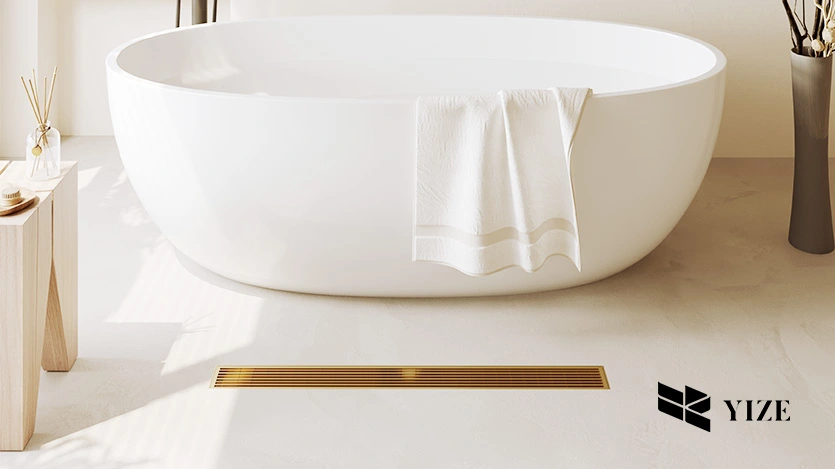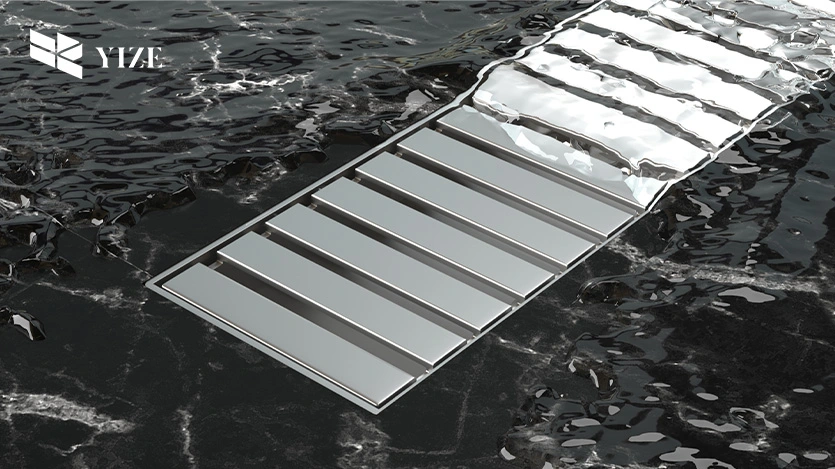
I. Introduction
A wetroom is a relatively new design approach to the modification of bathrooms and showers, which has been quite popular in recent years. A wetroom is unique from other bathrooms since it incorporates minimum barriers where the shower area is actually a leveled surface with the rest of the area. It is all waterproof and offers a practical and trendy solution for any home, particularly where space is limited. Another part that makes up a wetroom includes the drain, which should allow water to flow into and out of the room without compromising the building in the process. Specifically, wetroom linear drain is essential in the creation of a wetroom and have a functional purpose as well as an aesthetic one.
II. Are Linear Shower Drains Good for Wetrooms ?
Linear shower drains are especially efficient for wetrooms because of their construction and the way they work. Unlike point drains that are required to be set up on a four-way slope, linear drains are required to offer only a slope towards the drain and are hence much easier to install and provide better water drainage. Here are some key advantages of using linear drains in wetrooms:
●Aesthetic Appeal: These are straight and slim and perfect for a wetroom style as its design is chic and minimalistic. These can be fixed vertically against the wall or over the shower entrance which makes them less conspicuous as compared to traditional central drains.
●Efficient Water Management: The planar layout enables a better free-drop system of the water as well as resultant fast drainage of the entire wetroom.
●Flexibility in Design: These systems are available in many different sizes, types and finishes, which can make it easier to configure wet rooms. This flexibility makes them suitable to installations in both small and complex wetrooms.
●Easier Installation: The installation of linear drains involves a single slope, which makes it more convenient than traditional drain systems that need enhanced sloping. This can prove instrumental in saving time and at the same time,helping to eliminate installation errors as much as possible.
III. How to Install a Wetroom Linear Drain?
Before beginning the installation, gather the necessary tools and materials:
●Wetroom linear drain kit
●Waterproofing membrane
●Tile adhesive
●Trowel
●Level
●Measuring tape
●Circular saw or tile cutter
●Silicone sealant
●Grout
IV. Step-by-Step Installation Guide
●Plan the Layout: Firstly, consider the placement of the linear drain. This is usually mounted on a single wall or at the point where the shower entrance is located. It is also important to measure the location where the drain will be installed so that measurements and marks can be made.
●Prepare the Floor: Make sure the ground is flat and there is no dirt on the floor where the property is to be constructed. If the floor is uneven, fix it using self-leveling compound before laying the tiles. These areas should therefore have a flat surface to help facilitate adequate water drainage.
●Install the Drain Base: Install the base of the linear drain at the location specified by the manufacturer. Check to ensure that it is set upright and well positioned. Fasten this to the floor, using screws or adhesive, depending on the type of base of the chosen furniture.
●Waterproof the Area: A waterproofing membrane should then be placed over the entire floor area even the drain base. Make sure it extends over the joints and edges to avoid the formation of gaps that could compromise the watertightness of the structure. This step is important to avoid formation of water inlet.
●Create the Slope: Spread an even layer of tile adhesive on the floor and use a trowel to make the floor slightly inclined towards the line drain. This helps to ensure that water is channeled directly to the drain and does not remain on the surface.
●Install the Tiles: Start laying tiles from the area of the drain and continue working outwards; affording the need to cut the tiles in order to ensure they fit around the drain. This way, guarantee that the tiles are well aligned and conform to the slant in the direction of the drain.
●Seal and Grout: After the tiles are on, fill the gaps between the tiles and apply silicone sealant around the outer rim of the drain to facilitate an airtight seal. You should allow the grout and sealant to cure as recommended by the manufacturer of the particular materials used.
V. Measures to Employ to Guarantee an Air Tight Seal and Appropriate Pitch
●Make sure that the waterproofing membrane is well done to ensure that no gaps or bubbles exist at this stage.
●Level the floor throughout the process to ensure the slopes are uniform and that the water drains towards the drain.
●Choose materials that require sufficient curing time for adhesive, grout and sealant to avoid such problems as leakage in the future.
VI. Cleaning and Maintaining a Wetroom Linear Drain

It is important to keep your wetroom linear drain clean and properly maintained so that it would be useful for quite some time. Regular maintenance includes:
●Weekly Cleaning: Clean the drain cover and near area using diluted mild detergent and a sponge to eliminate buildup of soap scum.
●Monthly Inspection: Further, remove the drain cover if you have one and look down the drain channel for any obstruction. You can scrub the interior of the drain with a small brush or simply wipe it with a cloth moistened in water.
VII. Easy Cleaning Techniques
●Remove Trapped Debris: If you realize that water drains slowly in the sink, the drain might contain debris that is trapped. Remove any obstruction you can see with the help of drain cleaning tool or wire. This is important so that you do not cause any more harm on the drain.
●Deep Cleaning: It is also possible to take the drain cover off and clean it under warm water and soap for better results. Before replacing the brush, it is recommended to gently wash it with a soft brush to eliminate any hardening or deposits.
VIII. Conclusion
The use of linear drains bring a contemporary approach to wetrooms where beauty meets functionality. They are easy to fit and feature efficient water disposal systems which makes them a worthy investment in any wetroom project. If properly installed and maintained, a wetroom linear drain can last for several years without any problems. It may be advisable to select YZDRAIN linear drains as this is a more durable option that not only improves the practicality and aesthetics of a wetroom.
FAQs
1. What are the benefits of installing a linear drain rather than a point drain?
Single slope linear drains offer a more effective drainage system through a single slant that is easier to install and offers better control of water flow.
2. How often should I clean my linear drain?
Daily cleaning is advised, though weekly cleaning is more comprehensive, while a monthly inspection and cleaning are advised.
3. How often should I clean my linear drain?
Daily cleaning is advised, though weekly cleaning is more comprehensive, while a monthly inspection and cleaning are advised.
